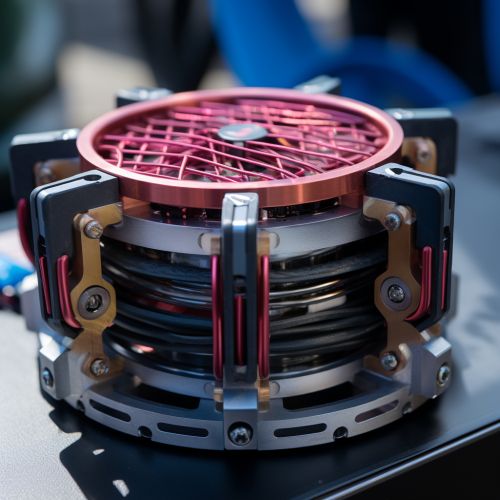Thermoelectric generator
Introduction
A Thermoelectric generator (TEG) is a type of energy harvester that converts heat energy, typically waste heat, directly into electrical energy. This is achieved through a phenomenon known as the Seebeck effect, named after the German physicist Thomas Johann Seebeck who discovered it in the 19th century.


Principle of Operation
The operation of a thermoelectric generator is based on the Seebeck effect. When two different types of semiconductors, typically n-type and p-type, are connected in a closed loop and the junctions are kept at different temperatures, an electromotive force (EMF) is generated. This EMF drives an electric current through the loop.
Components of a Thermoelectric Generator
A typical thermoelectric generator consists of the following main components:
- Thermoelectric materials: These are the semiconductors (n-type and p-type) that generate the EMF. Commonly used thermoelectric materials include bismuth telluride (Bi2Te3), lead telluride (PbTe), and silicon germanium (SiGe).
- Heat source: This is the source of heat that creates the temperature difference across the thermoelectric materials. It can be any source of waste heat such as an industrial process, a car exhaust, or even the human body.
- Heat sink: This is the component that absorbs the heat from the hot side of the thermoelectric materials and dissipates it to the environment. The heat sink is typically made of a material with high thermal conductivity such as copper or aluminum.
- Load: This is the electrical device that consumes the electricity generated by the thermoelectric generator. It can be a battery, a light bulb, a motor, or any other electrical device.
Thermoelectric Materials
The efficiency of a thermoelectric generator depends largely on the properties of the thermoelectric materials used. These properties include the Seebeck coefficient, the electrical conductivity, and the thermal conductivity. The performance of a thermoelectric material is often characterized by a dimensionless figure of merit, ZT, which is defined as:
ZT = S^2σT/κ
where S is the Seebeck coefficient, σ is the electrical conductivity, T is the absolute temperature, and κ is the thermal conductivity. A high ZT value indicates a good thermoelectric material.
Applications of Thermoelectric Generators
Thermoelectric generators have a wide range of applications, including:
- Waste heat recovery: Thermoelectric generators can be used to recover waste heat from industrial processes, power plants, and vehicles, and convert it into useful electrical energy.
- Remote power generation: Thermoelectric generators can be used to power remote sensing and communication devices where conventional power sources are not available.
- Spacecraft power systems: Thermoelectric generators, specifically radioisotope thermoelectric generators (RTGs), have been used to power spacecraft in deep space missions.
Advantages and Disadvantages of Thermoelectric Generators
Thermoelectric generators have several advantages over other types of energy harvesters. They are solid-state devices with no moving parts, which makes them highly reliable and maintenance-free. They can operate over a wide range of temperatures and can withstand harsh environmental conditions. They are also scalable and can be easily integrated into other systems.
However, thermoelectric generators also have some disadvantages. Their efficiency is relatively low compared to other types of energy harvesters. The cost of thermoelectric materials is also relatively high, which makes them less economical for large-scale applications.
Future Developments
Research is currently underway to develop new thermoelectric materials with higher ZT values. These materials could significantly improve the efficiency and cost-effectiveness of thermoelectric generators. There is also ongoing research on the use of nanotechnology to enhance the performance of thermoelectric materials.
